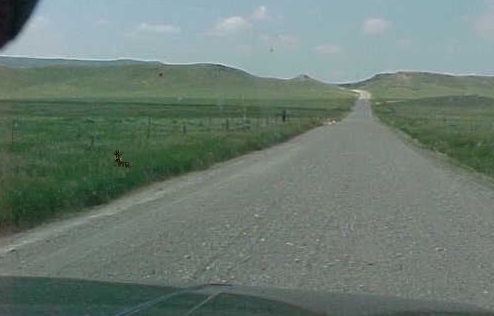
Jackalope on edge of road, south of Chugwater. For closeup see next photo.
Mythical animals are found throughout the world. Oregon has its sasquatch, Scotland the Loch Ness
Monster, Vermont's Lake Champlain its Champ, Nepal the yeti, and Florida its Bardin Booger.
Thus, it is only natural that Wyoming should have an animal whose existence is questioned.
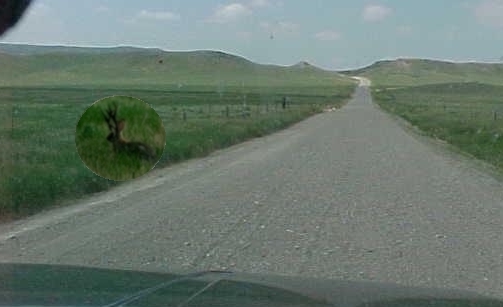
Closeup of Chugwater Jackalope
Douglas advertises itself as the jackalope center of the world. Jackalopes,
mythological antlered jack rabbits (but, perhaps with a grain of truth), appear
everywhere in the City, on city vehicles, on the City Seal, and on matchbooks. In the center of some cities are statues of
the City's founder, or statutes honoring Civil War dead. At the Center of
Douglas, as depicted to the lower left, is an eight foot high statue of a jackalope.
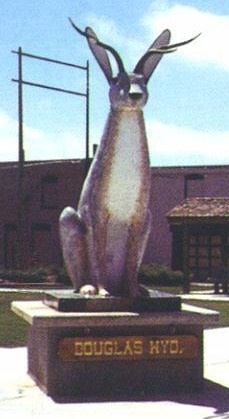 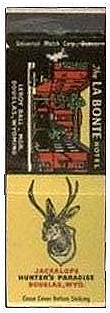 Left, Statue of Jackalope, Center Street, Douglas.
Left, Statue of Jackalope, Center Street, Douglas.
Right, matchbook LaBonte Hotel, Douglas
Exaggerated stories, incredible postcards, such as depicted below, sold at roadside eateries,
and hoaxes perpetuated by taxidermists,
make belief in the existence of the jackalope more difficult. Writers have attributed
its rarity to an ability to breed only during electrical storms. Another explanation given for the
paucity of jackalope sightings is that the animal is nocturnal and is, thus,
only observed by cowboys emerging from saloons at early morning hours.
It has been said that the jackalope moves so rapidly as to be confused with dust devils on freshly plowed
fields. Allegedly it can imitate the human voice and will join with cowboys singing
to their herds at night. Its milk has such unique qualities that its consumption is forbidden
to women.
Writers have contended that early trappers encountered the animal and that its
existence was known to the ancient Egyptians and to Europeans during the Middle Ages.
In 1939, Douglas taxidermist Douglas Herrick, inspired by a story told to him by
his grandfather who saw a stuffed jackalope in Buffalo years before, undertook
to create one by fastening antlers on a jack rabbit. The jack rabbit with antlers
was sold by Herrick to the LaBonte Hotel in Douglas for $10.00. There it was displayed in a
front window inspiring copies and the spread of the "legend." Thus, copies will now be found
in all states. Presidents of the United States have been presented with versions. Charles
Kuralt featured it on his television program.
In addition to the statue, other representations are featured at the State Fair and
proposals have been made to construct a giant 80 foot high jackalope near I-25 so as
to draw tourists into Douglas. The Chamber of Commerce issues jackalope hunting licenses authorizing
the taking of jackalopes on June 31 of each year.
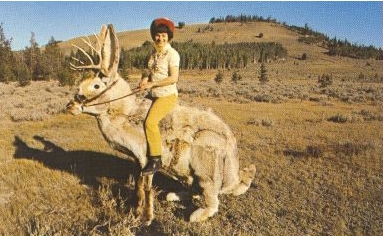 Jackalope Postcard
Jackalope Postcard
But as with all folk legends, someplace there may be a grain of truth. Young rabbits and hares are subject
to cutaneous warts caused by the Shope papilloma virus which is spread by
mosquitoes, Aedes aegypti, Anopheles, quadrimaculatus, Aedes triseriatus, and Culex pipiens.
The presence, however, of the virus is generally only in rabbits east of the
Mississippi. Humans are not susceptible to the virus. As the rabbit ages the warts disappear and an
immunity develops. The existence of the virus was first reported by R. E. Shope in 1933.
In some very rare instances, the warts can be so located on the rabbit and be of such a size as to
give the appearance of small, budding horns. Thus, it has been speculated that stories
of antlered rabbits were inspired by the appearance of rabbits suffering from
an infection by the virus.
|